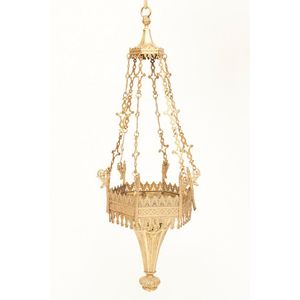Dragon-adorned Gothic chandelier
gilded brass Gothic revival hexagonal chandelier, in the manner of Augustus Welby Northmore Pugin, adorned with dragons and reticulated design, height 105 cm. Provenance: The collection of Robert Hutchinson, Sydney
You must be a subscriber, and be logged in to view price and dealer details.
Subscribe Now to view actual auction price for this item
When you subscribe, you have the option of setting the currency in which to display prices to $Au, $US, $NZ or Stg.
This item has been sold, and the description, image and price are for reference purposes only.
- Gilding - Gilding is a method of ornamentation whereby a thin sheet of gold metal is applied to items made of wood, leather, ceramics, glass and silver for decorative purposes.
For furniture including mirrors, the sheet of gold is usually applied over a coating of gesso. Gesso is a mixture of plaster of Paris and gypsum mixed with water and then applied to the carved wooden frames of mirrors and picture frames as a base for applying the gold leaf. After numerous coats of gesso have been applied, allowed to dry and then sanded a coat of "bole", a usually red coloured mixture of clay and glue is brushed on and allowed to dry, after which the gold leaf is applied. Over time parts of the gilding will rub off so the base colour can be seen. In water gilding, this was generally a blue colour, while in oil gilding, the under layer was often yellow. In Victorian times, gilders frequently used red as a pigment beneath the gold leaf.
Metal was often gilded by a process known as fire gilding. Gold mixed with mercury was applied and heated, causing the mercury to evaporate, the long-term effect of which was to kill or disable the craftsman or woman from mercury poisoning. The pursuit of beauty has claimed many victims, not the least of which were the artists who made those pieces so highly sought after today. - Pugin - Augustus Welby Northmore Pugin, (1812-52) was an architect and designer and leader of the Gothic Revival movement which was so important an influence on Victorian taste. His father had an architectural drawing school, and artists from that school, including Pugin, then 15 years old, were employed to make drawings of the furniture to be taken to Windsor palace. Later in the year he was employed to design and make working drawings of furniture for the palace. He also designed silver for the royal goldsmiths Rundell Bridge & Rundell. By the 1830s he was insisting on historical accuracy, and published a number of influential books on the Gothic style. He was responsible for furniture in the Houses of Parliament (1836-7) the design of the tower that houses Big Ben. He became a Catholic in 1833, and he and his son Edward Welby Pugin (1834-75) designed and built several churches. In his short life, he married three times. After his death Pugin's two sons, Edward Welby Pugin and Peter Paul Pugin, continued operating their father's architectural firm under the name Pugin & Pugin.
- Manner of .... / Style of ..... - A cataloguing term where the item, in the opinion of the cataloguer is a work in the style of the artist, craftsman or designer, possibly of a later period.
This item has been included into following indexes:
